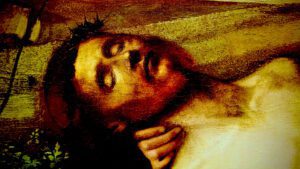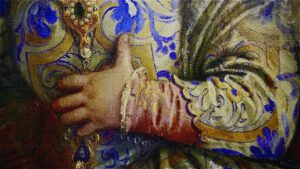
 In the 14th c. Sicilian painter, Antonello di Messina brought the new medium of oil painting to Italy. In his travels, he brought the medium to Venice, where artists such as Giovanni Bellini, adopted, and expanded the expressive potential of the medium. Perhaps one of the most influential painting teachers in history, Bellini’s pupils included some of the greatest figures in the history of the medium: Titian, Tintoretto, and Veronese. Their often huge, operatic paintings mark a kind of crowning achievement for the medium, and the processes they developed consequently influenced other great artists and schools of art that included Caravaggio, Rembrandt, Velazquez and countless others who have followed in their path.
In the 14th c. Sicilian painter, Antonello di Messina brought the new medium of oil painting to Italy. In his travels, he brought the medium to Venice, where artists such as Giovanni Bellini, adopted, and expanded the expressive potential of the medium. Perhaps one of the most influential painting teachers in history, Bellini’s pupils included some of the greatest figures in the history of the medium: Titian, Tintoretto, and Veronese. Their often huge, operatic paintings mark a kind of crowning achievement for the medium, and the processes they developed consequently influenced other great artists and schools of art that included Caravaggio, Rembrandt, Velazquez and countless others who have followed in their path.
This workshop will follow the oil painting methods of the great Venetian masters. Working from reproductions, participants will reproduce easel-sized works of the Venetian school of the 16th-18th c. They may also choose to copy a detail from larger Venetian masterworks. To as great an extent possible, students will use the same materials of 15th and 16th c. Venetian artists, many of which will be prepared by hand in class, according to traditional recipes.
Beginning on a uniquely coarse, stretched canvas (approximately 36” x 30”) prepared with rabbit skin glue and white lead, participants will apply a colored ground. This rich, colored surface establishes an overall, atmospheric tonality, that also functions as a very useful neutral color. This then, serves as the basis for the serendipitous approach to color and the remarkable atmospheric effects that are unique to this school of painting.
On this rich surface, participants will transfer perforated drawings with charcoal and a pounce as was done in this time. Afterward, earth colors, carbon black, and white lead ground in oil will be prepared by the class. With these basic colors, an underpainting will be developed using alternating layers of washes and thick impasto areas of white lead. Afterward, rich layers of transparent colors made primarily from pigments produced in in our Pigments and Paint Workshop will be applied. In the process, students will develop an unders tanding of the important terms, glaze (a dark, thinned color over a lighter surface) and scumble (a thin layer of white lead) as they seek to reproduce the sumptuous color and dramatic brushwork characteristic of the Venetian School.
tanding of the important terms, glaze (a dark, thinned color over a lighter surface) and scumble (a thin layer of white lead) as they seek to reproduce the sumptuous color and dramatic brushwork characteristic of the Venetian School.
During the class participants will have the unique opportunity to see remarkable examples of work by the Venetian masters in person during our excursion to the Pitti Palace in Florence.
Throughout the workshop, participants will be housed in the remarkably well-preserved Umbrian hill town of Monte Castello di Vibio. Your workshop package is all-inclusive, providing welcome and departure services and airport transfer from the Rome Fiumicino, Leonardo Da Vinci Airport (FCO). Aboard our comfortable private bus, single occupancy accommodations with shared bath (a wide range of upgrades with private bath are available), 3 meals per day Monday-Thursday, Prosecco brunch and dinner on Saturday and Sunday (no meals are served on Friday, our excursion day. Your workshop includes an excursion to Florence. Of course, throughout your stay, 24/7 access to facilities and 24/7 bi-lingual support are provided.
Price of the workshop includes all materials needed to produce the painting described above, except brushes, which will be available for sale at ICA in Italy. While it is unlikely that the painting will be completed in the timeframe allowed by the workshop, our goal is to give participants a sufficient understanding of the Venetian process in order to complete the painting at home. As part of the course fee, participants will be issued a unique folding stretcher that allows the painting itself to be folded into a carry-on luggage-sized parcel, even if not fully dry.